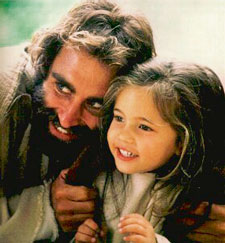It is fairly clear that the director of this production sat Bruce Marchiano down and told him to laugh and smile at every opportunity - even the inappropriate ones. The Jesus that emerges is a thoroughly likeable human being whom grandmothers would most likely describe as 'lovely'. How he manages to wreck the Temple is anyone's guess.
It is very hard to take Matthew seriously, on multiple levels.
 The double DVD production is hamstrung by technical, geographical and financial problems. The 4:3 made-for-television ratio looks sadly dated in a wide-screen world. Worse, there is some very poor audio dubbing for some characters, which is occasionally out of synchronization with the pictures. The background audio is similarly poor, with sudden jumps in 'noise' associated with scene changes. The decision to film the entire production in South Africa also gives rise to a whole raft of problems. There are snowy peaks in the background as Mary and Joseph journey to Egypt, and the Sea of Galilee looks distinctly like a mountain lake. The location has also impacted on the ethnic groups available for actors. Consequently there are some very white and very people pretending to be Jewish.
The double DVD production is hamstrung by technical, geographical and financial problems. The 4:3 made-for-television ratio looks sadly dated in a wide-screen world. Worse, there is some very poor audio dubbing for some characters, which is occasionally out of synchronization with the pictures. The background audio is similarly poor, with sudden jumps in 'noise' associated with scene changes. The decision to film the entire production in South Africa also gives rise to a whole raft of problems. There are snowy peaks in the background as Mary and Joseph journey to Egypt, and the Sea of Galilee looks distinctly like a mountain lake. The location has also impacted on the ethnic groups available for actors. Consequently there are some very white and very people pretending to be Jewish.
The small-scale budget has also impacted on the sets and the costuming - King Herod's palace is clearly some public building chosen simply for its marble staircases, and there are numerous extras who really do look like they are wearing someone's table cloth on their head. The storm on the sea of Galilee is frankly laughable and the consequences are the impression that Christians have made a big deal about nothing in particular.
All of the production's effort seems to have been put into trying to make Jesus as human as possible, but the results are mixed at best.
The Visual Bible's production of the Gospel of Matthew was one of the first modern productions to embrace the humanity of Jesus. Gone were the declaratory statements and somber, unearthly looks. Instead the viewer is presented with a man who seems incapable of talking to someone without embracing them. Marchiano's Jesus comes off much more like an American evangelist in the way he greets and extends a hand to people, than the Son of God on a mission. Even when he is ticking off the Pharisees he still manages a grin and his most serious condemnations appear more wistful than angry. The messiah presented in Matthew was one who 'wasn't hurting anyone' and his persecutors were people who 'took themselves too seriously'.
The greatest limitations of Matthew, however, relate to its structure. Its claim to be 'the only dramatization using the actual Scriptures. word for word." sounds great but it is less of a selling point in reality.
The narration of the story is carried out by an elderly Matthew who is now recording his memories, presumably with an eye on generations of Christians to come. However the decision to have the aged apostle personally dictating to scribes leaves the production open to serious historical criticisms. Further, the fact that Matthew is doing this dictation while carrying out household chores detracts from the gravity and importance of the recordings. They resemble more the rambling memories of an old man rather than the carefully memorized histories of a community. Frankly, laughing with children and smiling at babies seriously distracts from what he has to share.
The inclusion of graphics that show which particular verse the film is presenting can be helpful. However the slavish devotion to the actual text makes for very boring and generally unbelievable video. The producers' determination not to allow any other dialogue to enter into the production that is not directly quoted in Scripture leads to strange situations, like the narrator cutting into dialogue to insert things like 'he said' and 'he replied'. Further Jesus carries out life-changing healings but the objects of his mercy cannot say a single word of thanks, and are reduced to guttural expressions of joy. Even those who opposed Jesus are constantly silent, making them seem like no opponents at all.
In summary Matthew presents itself as more of clumsy colouring in of the Gospel text rather than a powerful pictorial presentation of the greatest story ever told.















